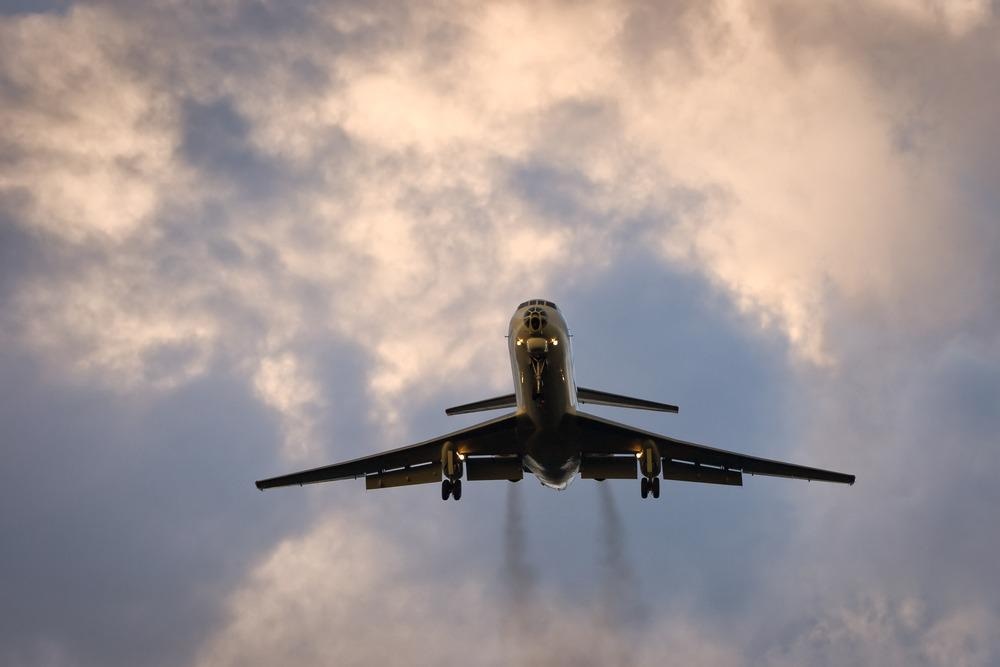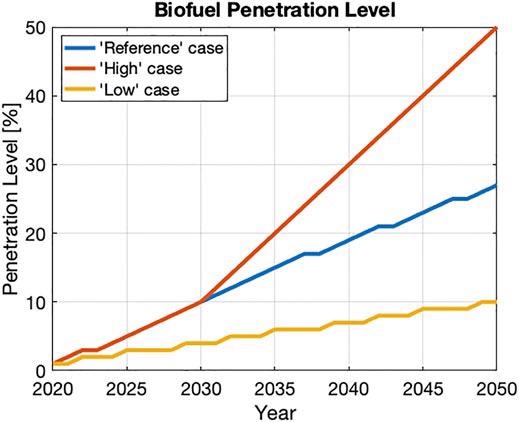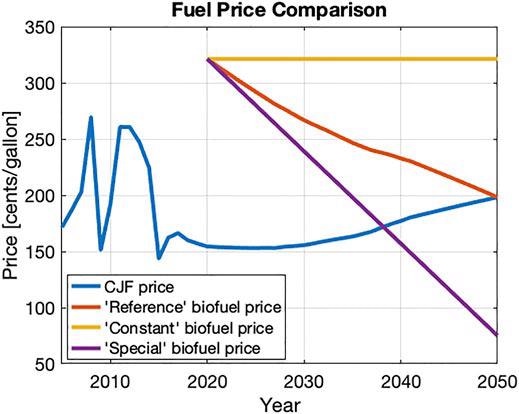With the recent COP26 climate change conference and ongoing discourse around the Paris Agreement, global industries must find ways of cutting emissions to meet 2030 targets of 55% below 1990 levels of greenhouse gas emission. The aviation industry is currently committed to reducing net aviation CO2 emissions by 50% by 2050, relative to 2005 levels.

Study: Estimating The Reduction In Future Fleet-Level CO2 Emissions From Sustainable Aviation Fuel. Image Credit: Oleg V. Ivanov/Shutterstock.com
Recently have presented one of the first studies, published in the journal Frontiers in Energy Research, that investigates the impact of operating commercial aircraft using sustainable aviation fuel (SAF). The study, published in Frontiers, models the behavior of a profit-seeking airline utilizing the Fleet-Level Environmental Evaluation Tool (FLEET) to make its assessment.

Different biofuel penetration level cases considered in this study. Image Credit: Jain, Samarth et al., Frontiers in Energy Research
One of the factors that makes this an enticing solution is the fact it requires minimal modification to existing aircraft making it the ‘quickest’ approach to reducing aviation carbon emissions: “the actual impact will be determined by the degree to which airlines adopt and use SAF, the ticket price impact of SAF, and the future growth of travel demand, explains Samarth Jain, lead author, and Graduate Research Assistant at Purdue University.
Modeling Tool FLEET
In order to suitably evaluate the environmental impact of SAF on commercial airline travel, it is necessary to model airline operations, model and forecasts future passenger demand, and also model the introduction and future use of various aircraft types.
Fleet-Level Environmental Evaluation Tool (FLEET) is a system dynamics-inspired simulation that combines all these models into a single tool. FLEET estimates future fleet-level CO2 emissions, demonstrates the possible upper and lower bounds on future aviation emissions when introducing SAF for use in airline fleets.
“The tool can reflect the performance of new technology aircraft that are predicted to consume less fuel and generate less noise than current aircraft; with these aircraft models, FLEET simulates how an airline would use these new aircraft to meet passenger demand on a route network,” Jain says.
Sustainable Aviation Fuel (SAF)
'Sustainable', 'aviation', and 'fuel' are three terms you may not consider to be congruent but since 2016, SAF has been used in over 370,000 flights and counting. SAF can be made from renewable sources such as plants, cooking oil, municipal waste including textiles and food waste, and woody biomass.
Today, HEFA is the only SAF being used in aviation, HEFA refines vegetable oils, waste oils, or fats and converts them into SAF via hydrogenation. It is a safe, proven fuel, which can reduce lifecycle emissions by up to 80%, compared with traditional aviation fuel.

Comparison of Conventional Jet Fuel (CJF) price in FLEET with “Reference,” “Constant,” and “Special” biofuel price (in 2005 U.S. Dollars). Image Credit: Jain, Samarth et al., Frontiers in Energy Research
SAF is also a drop-in fuel, which means it can be added to standard jet fuel in a ratio of up to 50% for use in aircraft operating today. Around 14 billion liters of SAF are in forward purchase agreements as over 45 airlines are now implementing its use to meet aviation industry targets and long-term climate goals.
Future Impact Scenarios
The researchers ran five future SAF scenarios and two future passenger demand projections in order to assess future impact scenarios of biofuel utilization which are fully detailed in the study. Overall, the results suggest that the introduction SAF for use in airline fleets and the projected demand scenarios could significantly impact the future fleet-level aviation CO2 emissions.
The researchers do make clear that SAF penetration levels should exceed 50% if being used as a drop-in fuel in order to have the best possible outcome but generally the use of SAF indicates that future emissions can decrease: “With the current modeling, introducing SAF with ‘High’ penetration levels could lead to the lowest possible emissions, serving as the ‘best case scenario’ for future aviation CO2 emissions,” explains Jain.
![System-dynamics-inspired representation of FLEET [adapted with permission from (Moolchandani et al., 2017)].](https://www.azom.com/images/news/ImageForNews_57535_16383614688251563.jpg)
System-dynamics-inspired representation of FLEET. Image Credit: Jain, Samarth et al., Frontiers in Energy Research
One of the striking features of the study is that it revealed that even if airlines serve a higher passenger demand for some future scenarios, potentially, the carbon emissions could still be lower than the present baseline scenario – conventional jet fuel use.
Therefore, increasing the use and roll-out of SAF for use in the commercial aviation industry could assist in putting the industry as a whole on the track towards meeting its 2050 commitments and achieving its four-pillar action plan: improved technology; more efficient operations; infrastructure improvement; and a single global market-based measure, to fill the remaining emissions gap.
References & Further Reading
Jain, Samarth et al. "Estimating The Reduction In Future Fleet-Level CO2 Emissions From Sustainable Aviation Fuel". Frontiers In Energy Research, vol 1, 2021, DOI: https://www.frontiersin.org/articles/10.3389/fenrg.2021.771705/full
International Air Transport Association, ‘Sustainable Aviation Fuel’. IATA.org [https://www.iata.org/en/programs/environment/climate-change/ accessed December 2021]
International Air Transport Association, ‘Working Towards Ambitious Targets’. IATA.org [https://www.iata.org/en/programs/environment/climate-change/ accessed December 2021]
Disclaimer: The views expressed here are those of the author expressed in their private capacity and do not necessarily represent the views of AZoM.com Limited T/A AZoNetwork the owner and operator of this website. This disclaimer forms part of the Terms and conditions of use of this website.